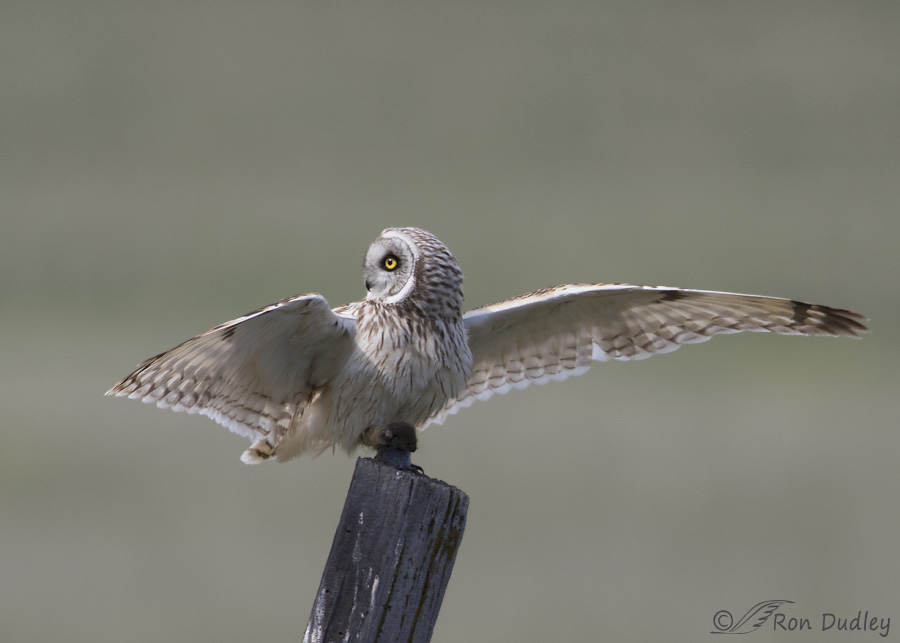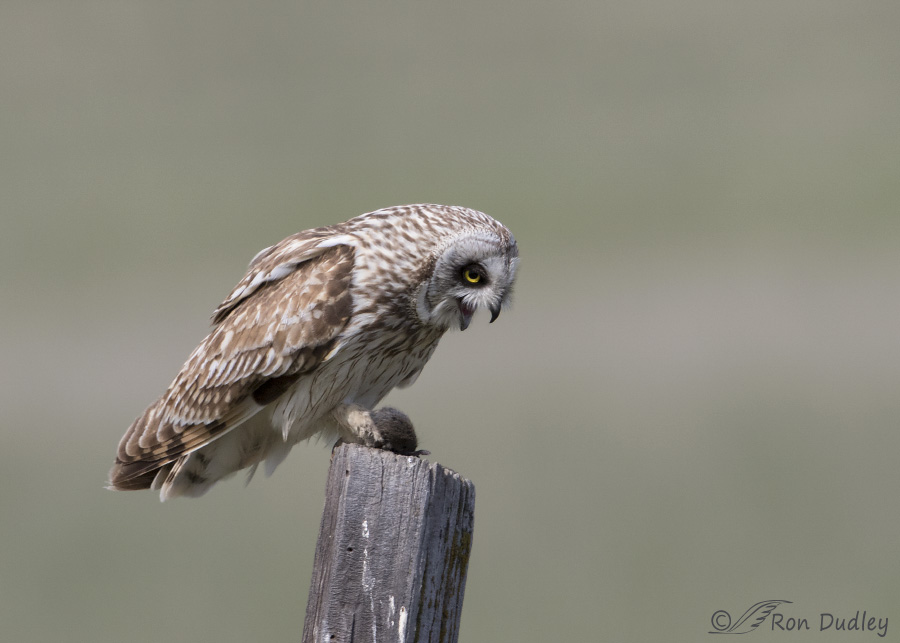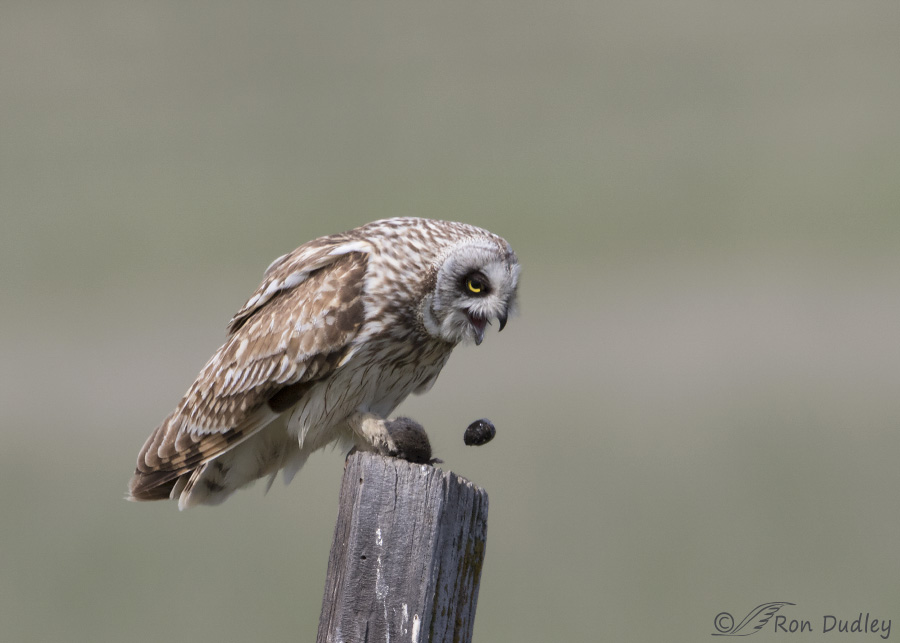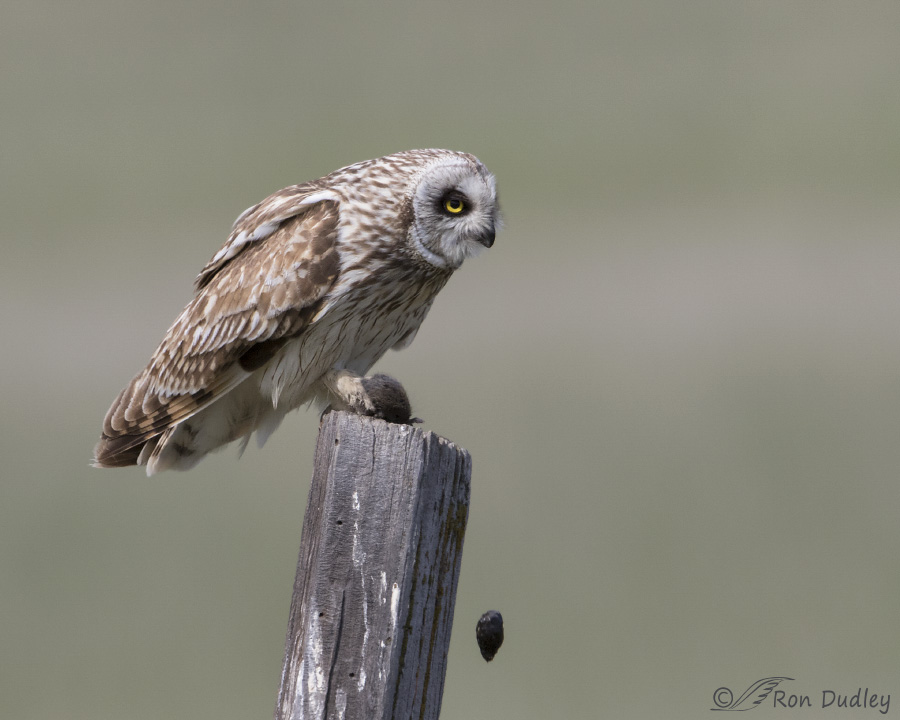Yesterday morning in northern Utah this Short-eared Owl had a surprise waiting for me and it came at an unexpected moment.

1/2000, f/6.3, ISO 500, Canon 7D Mark II, Canon EF 500mm f/4L IS II USM + 1.4 tc, not baited, set up or called in
Here the owl is landing on a fence post with a vole it had just captured.

1/1600, f/7.1, ISO 500, Canon 7D Mark II, Canon EF 500mm f/4L IS II USM + 1.4 tc, not baited, set up or called in
Almost immediately after landing the bird began to retch. Usually when I photograph birds throwing pellets it’s when they’ve been perched and resting for a while and this one had freshly caught prey that was still alive to deal with so I certainly didn’t expect to see pre pellet-casting behavior before the owl had dispatched the vole. Those little guys can, and often do, bite. Rodent teeth are definitely to be avoided if at all possible.

1/1600, f/7.1, ISO 500, Canon 7D Mark II, Canon EF 500mm f/4L IS II USM + 1.4 tc, not baited, set up or called in
But sure enough, out came a pellet. Based on its trajectory I believe it hit the edge of the post…

1/1600, f/7.1, ISO 500, Canon 7D Mark II, Canon EF 500mm f/4L IS II USM + 1.4 tc, not baited, set up or called in
before falling to the ground.
Some factoids about pellet casting in Short-eared Owls:
- pellets consist of indigestible hair, bones and teeth
- on average they throw one pellet per meal
- interval between pellets is related to the weight of the meal but averaged 8.5 hours after eating meals averaging 35 grams
So I was very lucky to capture this behavior if it only occurs every 8.5 hours.
I’ve photographed quite a few individual birds of a variety of species casting pellets but ironically I believe this is only the second time I’ve ever captured an owl doing so. Ironic because owls are the group of birds that is best known for casting them.
Ron


Wonderful behavioral shots Ron!
Charlotte
Thanks, Charlotte.
It is well before dawn here still and I am already in learning (and marvelling) mode. Thank you and Laura for both.
And yes, having been bitten by an ungrateful mouse I ‘saved’ from a cat I agree they have sharp and pointy teeth.
You must be like me, EC. I’m on the computer in the morning before I even get my first cup of coffee poured. Turning the computer on is the only thing I’m capable of before coffee…
Amazing captures and so interesting Ron!!! I continue to love your photos and stories!!!
Thanks very much, Pamela.
OK, here’s the diagram I was REALLY looking for about how pellets work. I think I have most everything in my notes somewhere. The exact where part is oftentimes problematic.
https://is.gd/WaQztt
Thanks, Laura. I enjoyed both of them.
And congrats for finding it! Perseverance ya know…
Tenacity and persistence works in many of life’s little challenges. Coffee helps, although in this case, it was more an issue of Google is your friend! Tool usage is good, too. LOL!
It’s great that you were able to capture this behavior. I’m enjoying your posts of Short-eared Owls – a bird I’ve never seen in the wild. They are beautiful. The pose in the landing shot reminds me of a Burrowing Owl, which makes me smile.
Susan, we have a bonanza of SEO’s in northern Utah this year, which is quite a change from recent years around here. They’re very well known for being nomadic and only nesting in areas that have an abundance of prey. Since vole populations are highly variable and cyclic, where SEO’s are abundant one year they may be almost completely absent the next year.
Great capture!
8.5 hours, man you are ‘Johny on the spot’ for this shot.
I would think posts like this would be earmarked by a science teacher so he/she could pick up these cast pellets. Great teaching possibility here for some enterprising teacher. Been there done that, but a ton harder in a deciduous forest.
Dick, I used to have teachers that occasionally used my blog in their classrooms. I’m not sure if that is still happening.
Just a case of out with the old and in with the new And again, insert all the regular superlatives!
And again, insert all the regular superlatives!
The hawks/falcon who live with me generally cast once a day, right around 1:00 p.m. (give or take about 30 minutes), just in time to go hunting/eating again. What an amazing process.
I have a really cool diagram of how casting works with an owl. As soon as I find it, I’ll share it. Evidently I put it in a safe place, somewhere that made perfect sense to me at the time of putting but that totally escapes me right now (pre-coffee mind). I’m still looking and when I get to the finding part…
For the teachers out there who want to purchase owl pellets for their classes, please be aware that some of the products available out there are not owl pellets at all but manufactured facsimiles that aren’t accurate! When I learned that, I couldn’t help but ask, “Who would DO that?”
“some of the products available out there are not owl pellets at all but manufactured facsimiles that aren’t accurate”
Laura, when I found that out years ago I stopped purchasing them for my classroom.
Sounds like your birds have a regular schedule for casting pellets. Do you feed them/hunt them at a regular time? I’m interested in the time frame between eating and casting. From what you said it’s implied that it’s a little less than 24 hours – is that correct?
Yes, for “my” redtail, Harris’ hawk and Kestrel, it’s roughly 22 to 23 hours, give or take. We generally hunt in the afternoon, the exact time depending on what time sundown happens. And if for some reason they haven’t done their casting, they’re not all that interested in hunting. Thus, I make sure there’s a fresh casting before we leave the house. So they’re fed at roughly the same time every day, even during the molt, although that’s also dependent on what time sundown happens. Now, I’m feeding them about 3 to 5 p.m. where in December they’re generally eating around 1 to 3 p.m. They eat every day whether they catch something, or not.
In my world, there are perks to being a falconry bird. The other advantage to this system is that if their crops are not empty in the morning, there’s something obviously wrong (sour crop) so I can act immediately before that becomes a real issue. I’ve only dealt with sour crop once back when I was an apprentice 21 years ago and didn’t know any better, and since I really do NOT want to go there EVER again, this system works splendidly.
Obviously in the wild, casting times would vary depending on what they eat and when and there’s no schedule in The Great Out There.
NOTE: These birds are no more MINE than the air I breathe, but our language has issues.
Still looking for that really cool diagram…sigh. HA! Finally found it!
http://www.owlpages.com/owls/articles.php?a=4
Thanks for answering my question, Laura. And for the diagram and article.
I found this part of the article particularly interesting – “new prey cannot be swallowed until the pellet is ejected”. Perhaps that explains the timing of the casting of my owl – the bird couldn’t eat the vole until it passed the pellet.
Interesting Ron…I didn’t know that it was an absolute that they couldn’t eat the new until the pellet had been cast. I don’t think that’s true with hawks/falcons, but as always, I could be wrong. I’m only 97.792% sure that’s not true with hawks/falcons, but that might also be with small castings. I’ve just always tried to make sure they’ve done the deed before we go hunting
With “your” owl, that was a pretty big casting that took up a lot of room, too.
Laura, Buteos, falcons and vultures have a crop. Owls do not. So I suspect that raptors other than owls can eat before casting the latest pellet.
Well DUH Ron (thwaps forehead)! Wish I’d put those pieces of knowledge together in an appropriate fashion. Alas, no–not this time. This geezer thing is stressful. While you know a lot, putting it together is often problematic! DUH!
Geez Laura, I’m doing that all the time – putting something down in a SAFE place and then I’ll spend huge amounts of time trying to find it!
Don’t feel like the Lone Ranger, Dick…
About the only important thing I never misplace is my 500mm lens, though I regularly have dreams/nightmares about doing exactly that. I’m sure Freud would have something to say about that!
At least for now we can laugh about it?
Dick/Ron, I’ve even tried a designated “safe place,” and while that SEEMED to be a good idea to avoid losing things, it didn’t work. I lose things all the time. The really annoying times are when I haven’t moved since I had whatever the lost thing is in my hand just 30 seconds prior for pity’s sake! Then, I get obsessed with finding whatever it is until I find it. Sometimes, that’s a tilting at windmills endeavor. It’s not easy being a geezer, is it? LOL!
It’s not easy being a geezer, is it? LOL!
At this point, I’ve found that being obsessive about putting things in one place always (keys on a hook, for example) helps a lot. Redundancy is also a good practice
Love the first photo! It is quite a process to get rid of the pellets at times.
It is quite a process to get rid of the pellets at times.
Judy, it can be a real struggle but this owl did it quickly and (seemingly) effortlessly. I’ve seen some raptors look like they were choking to death during the process.
The owl photos are magnificent, Ron!! As for casting the pellet, I feel for them because it’s obviously not an easy thing to get out!! I know from watching the eagle nest that it can take a while to get it out and always feel for the young birds when it’s a new experience for them! I do have a question. Did the owl cast the pellet without being bitten by the vole?!
“Did the owl cast the pellet without being bitten by the vole?!”
I believe so, Jo Ann. But the owl was very careful about how it dispatched the vole. I’ve seen raptors (and coyotes) bitten by voles more than once.
Voles can be feisty for sure! Both our dog and cat have been bitten by them “playing” with one.
Judy, the reaction of a coyote when bitten on the tongue by a vole is hilarious to watch, though I also have empathy for them when it happens.